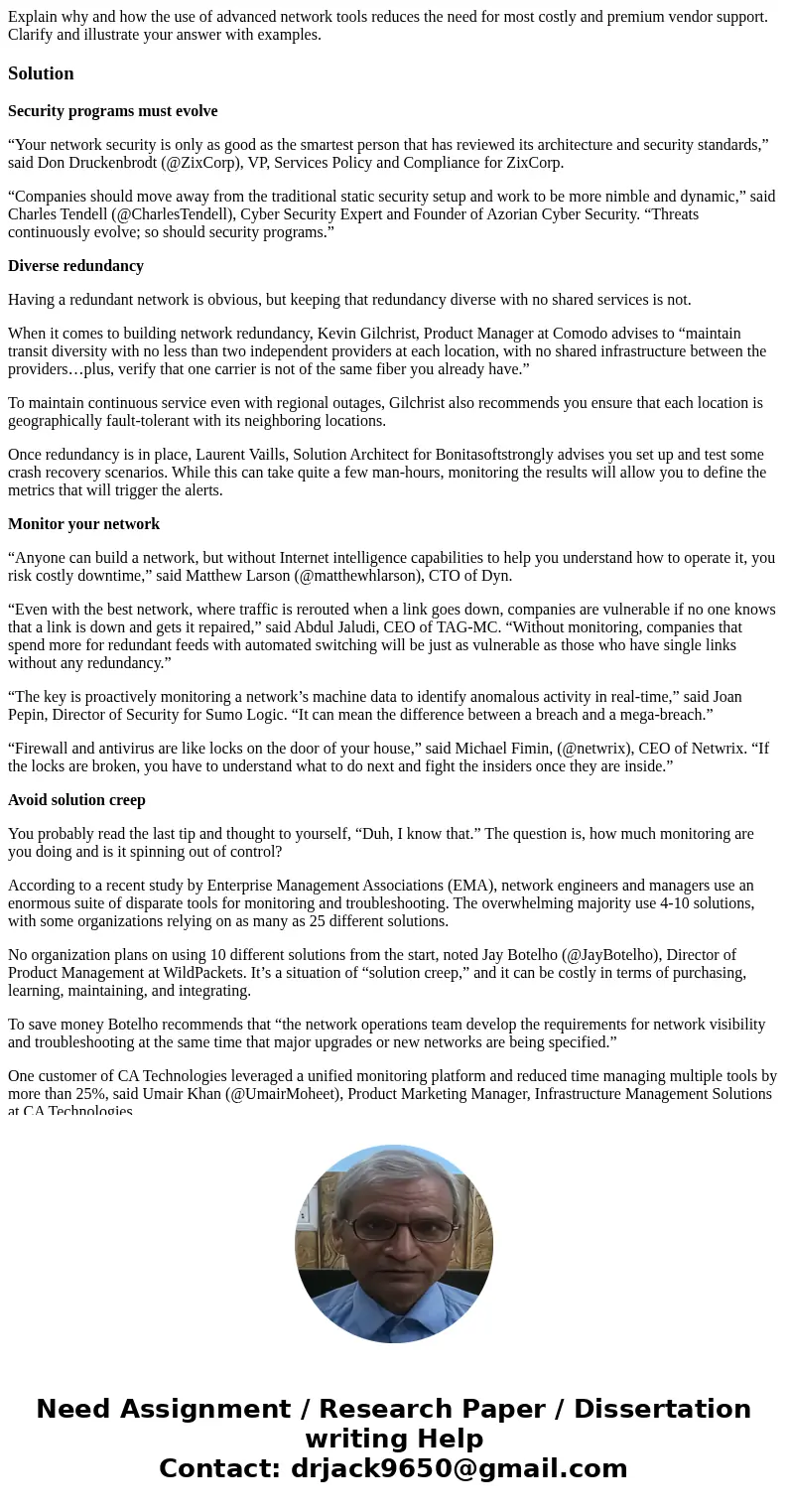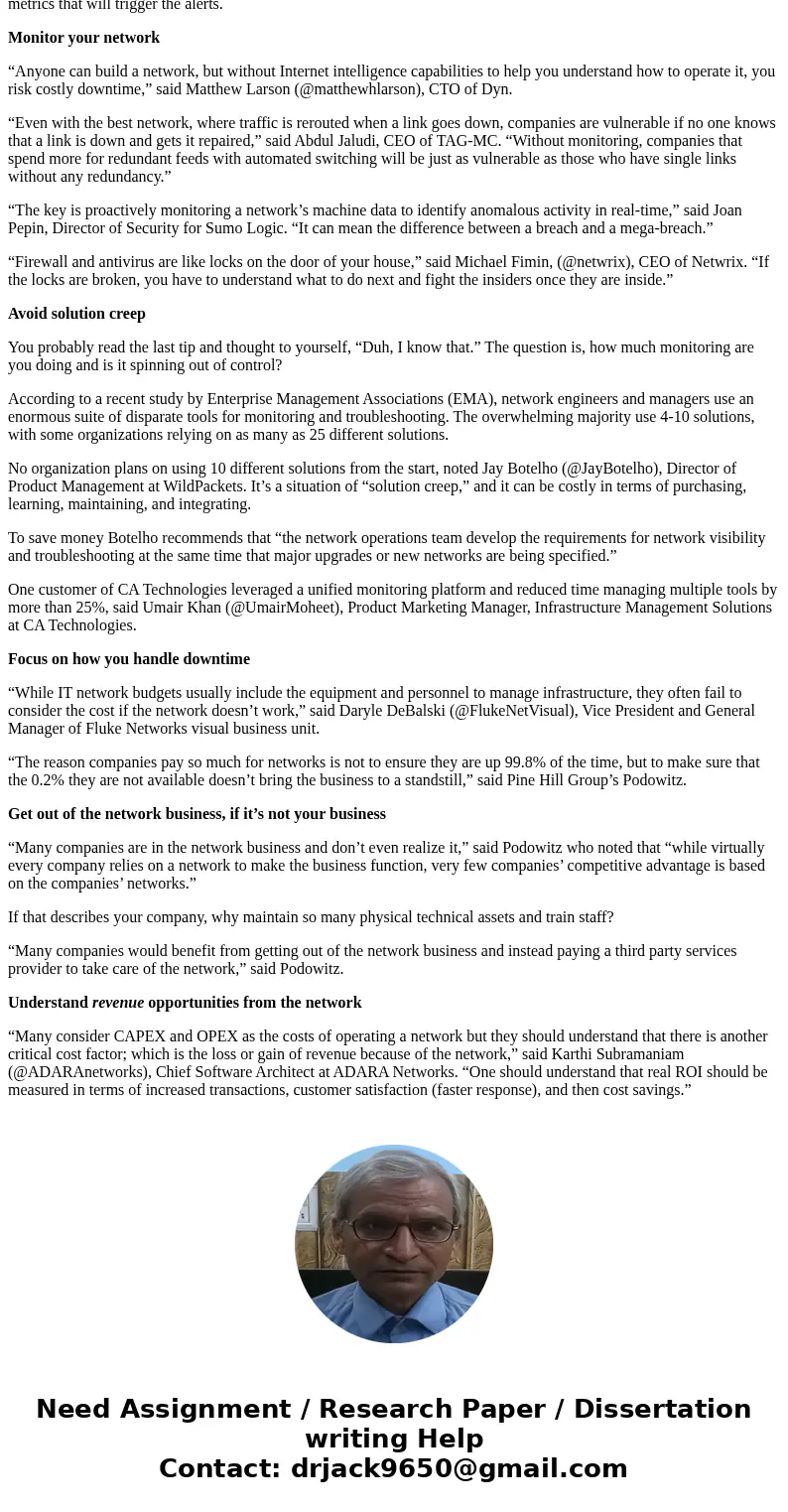Explain why and how the use of advanced network tools reduce
Explain why and how the use of advanced network tools reduces the need for most costly and premium vendor support. Clarify and illustrate your answer with examples.
Solution
Security programs must evolve
“Your network security is only as good as the smartest person that has reviewed its architecture and security standards,” said Don Druckenbrodt (@ZixCorp), VP, Services Policy and Compliance for ZixCorp.
“Companies should move away from the traditional static security setup and work to be more nimble and dynamic,” said Charles Tendell (@CharlesTendell), Cyber Security Expert and Founder of Azorian Cyber Security. “Threats continuously evolve; so should security programs.”
Diverse redundancy
Having a redundant network is obvious, but keeping that redundancy diverse with no shared services is not.
When it comes to building network redundancy, Kevin Gilchrist, Product Manager at Comodo advises to “maintain transit diversity with no less than two independent providers at each location, with no shared infrastructure between the providers…plus, verify that one carrier is not of the same fiber you already have.”
To maintain continuous service even with regional outages, Gilchrist also recommends you ensure that each location is geographically fault-tolerant with its neighboring locations.
Once redundancy is in place, Laurent Vaills, Solution Architect for Bonitasoftstrongly advises you set up and test some crash recovery scenarios. While this can take quite a few man-hours, monitoring the results will allow you to define the metrics that will trigger the alerts.
Monitor your network
“Anyone can build a network, but without Internet intelligence capabilities to help you understand how to operate it, you risk costly downtime,” said Matthew Larson (@matthewhlarson), CTO of Dyn.
“Even with the best network, where traffic is rerouted when a link goes down, companies are vulnerable if no one knows that a link is down and gets it repaired,” said Abdul Jaludi, CEO of TAG-MC. “Without monitoring, companies that spend more for redundant feeds with automated switching will be just as vulnerable as those who have single links without any redundancy.”
“The key is proactively monitoring a network’s machine data to identify anomalous activity in real-time,” said Joan Pepin, Director of Security for Sumo Logic. “It can mean the difference between a breach and a mega-breach.”
“Firewall and antivirus are like locks on the door of your house,” said Michael Fimin, (@netwrix), CEO of Netwrix. “If the locks are broken, you have to understand what to do next and fight the insiders once they are inside.”
Avoid solution creep
You probably read the last tip and thought to yourself, “Duh, I know that.” The question is, how much monitoring are you doing and is it spinning out of control?
According to a recent study by Enterprise Management Associations (EMA), network engineers and managers use an enormous suite of disparate tools for monitoring and troubleshooting. The overwhelming majority use 4-10 solutions, with some organizations relying on as many as 25 different solutions.
No organization plans on using 10 different solutions from the start, noted Jay Botelho (@JayBotelho), Director of Product Management at WildPackets. It’s a situation of “solution creep,” and it can be costly in terms of purchasing, learning, maintaining, and integrating.
To save money Botelho recommends that “the network operations team develop the requirements for network visibility and troubleshooting at the same time that major upgrades or new networks are being specified.”
One customer of CA Technologies leveraged a unified monitoring platform and reduced time managing multiple tools by more than 25%, said Umair Khan (@UmairMoheet), Product Marketing Manager, Infrastructure Management Solutions at CA Technologies.
Focus on how you handle downtime
“While IT network budgets usually include the equipment and personnel to manage infrastructure, they often fail to consider the cost if the network doesn’t work,” said Daryle DeBalski (@FlukeNetVisual), Vice President and General Manager of Fluke Networks visual business unit.
“The reason companies pay so much for networks is not to ensure they are up 99.8% of the time, but to make sure that the 0.2% they are not available doesn’t bring the business to a standstill,” said Pine Hill Group’s Podowitz.
Get out of the network business, if it’s not your business
“Many companies are in the network business and don’t even realize it,” said Podowitz who noted that “while virtually every company relies on a network to make the business function, very few companies’ competitive advantage is based on the companies’ networks.”
If that describes your company, why maintain so many physical technical assets and train staff?
“Many companies would benefit from getting out of the network business and instead paying a third party services provider to take care of the network,” said Podowitz.
Understand revenue opportunities from the network
“Many consider CAPEX and OPEX as the costs of operating a network but they should understand that there is another critical cost factor; which is the loss or gain of revenue because of the network,” said Karthi Subramaniam (@ADARAnetworks), Chief Software Architect at ADARA Networks. “One should understand that real ROI should be measured in terms of increased transactions, customer satisfaction (faster response), and then cost savings.”


 Homework Sourse
Homework Sourse